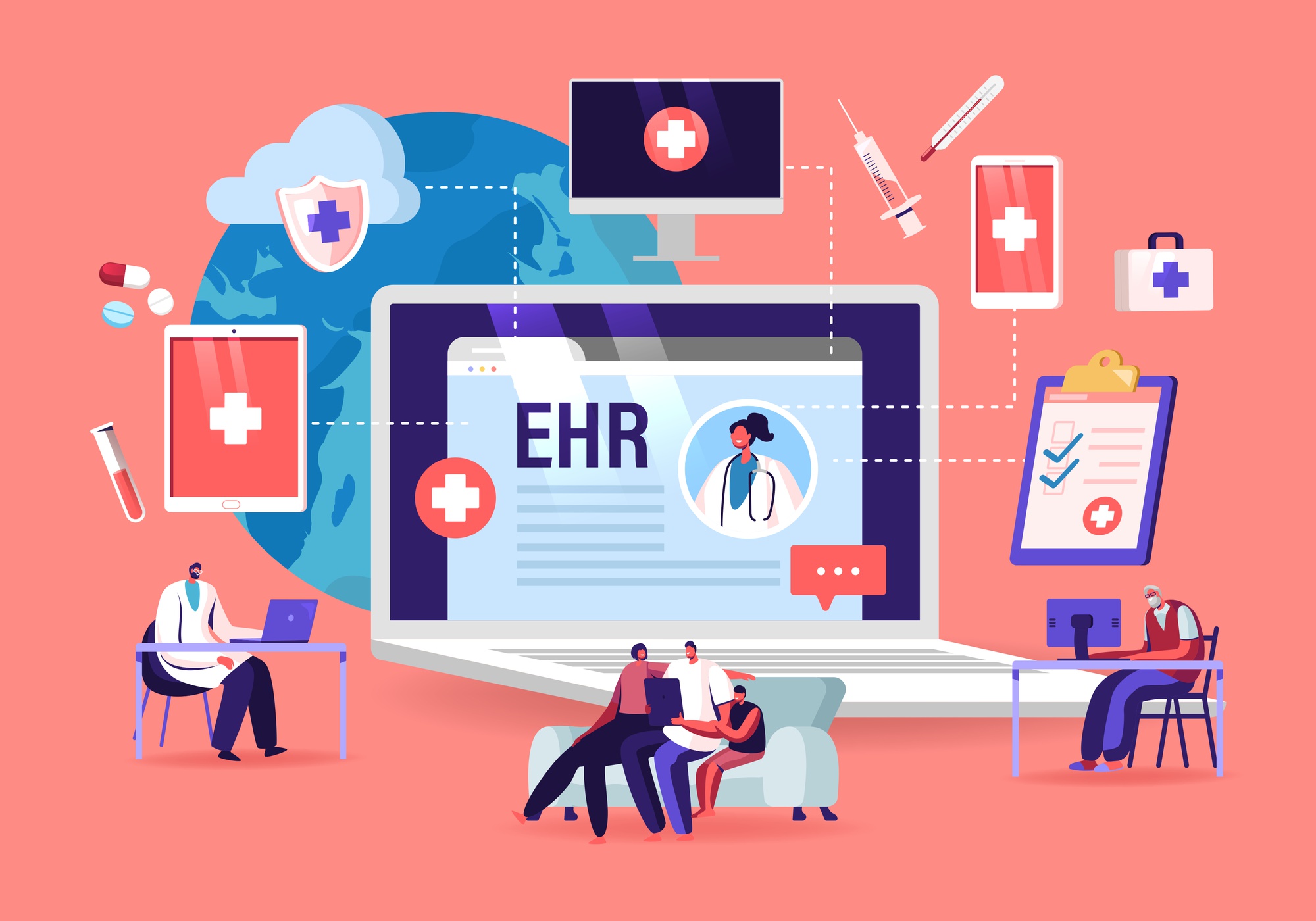My name is Sabrina Ladd and am currently enrolled in a family nurse practitioner program. This blog is being created as an information resource for my nursing informatic class. Over the next 8 weeks content will be posted regarding relevant topics in nursing informatics. Each week an assigned topic will be discussed, and resource links will be provided to become better informed and educated on each topic. Come along for my ride and journey with me through my nursing informatics class.
Sabrina's Reflections on Advanced Practice Nurse and Information Technology.
Wednesday, April 24, 2024
Monday, April 15, 2024
Week 7 Reflection
WEEK 7 REFLECTION
HEALTHCARE CLOUDS
- Identify and discuss "Healthcare Cloud" ... what is it?
- How may the Nurse Practitioner use the Healthcare Cloud with his/her patients?
- How can patient privacy and confidentiality be best protected?
Monday, April 8, 2024
Week 6 Reflection
WEEK 6 REFLECTION
Early outcomes of electronic health records-based quality measurements (eCQMs) and Meaningful Measures
What are electronic health records-based quality measurements (eCQMs)?
Electronic clinical quality measures eCQMs are measures specified in a standard electronic format using data electronically extracted from electronic health records (EHRs) and/or health information technology (IT) systems to measure the quality of health care provided. The Centers for Medicare & Medicaid Services (CMS) uses eCQMs in a variety of quality reporting and value-based purchasing programs.
CMS eCQMs measure many aspects of patient care, including:
- Patient and Family Engagement
- Patient Safety
- Care Coordination
- Population/Public Health
- Efficient Use of Healthcare Resources
- Clinical Process/Effectiveness
There are several benefits of using eCQMs:
- eCQMs use clinical data to assess the outcomes of treatment by measured entities.
- eCQMs use electronic standards, which help reduce the burden of manual abstraction and reporting for measured entities.
- eCQMs foster the goal of access to real-time data for point of care quality improvement and clinical decision support.
- Priorities & Measure Gaps
Digital Quality Measurement
Person-Centered Care
Cascade of Meaningful Measures
Next Steps
meaningful measures play crucial roles in assessing and improving patient safety and healthcare quality.
Meaningful Measures:
- Background:
- The Meaningful Measures Initiative was introduced by the Centers for Medicare & Medicaid Services (CMS) in 2017.
- Its initial goal was to reduce the number of Medicare quality measures and ease the burden on measured entities.
- Meaningful Measures 2.0:
- Evolution: The initiative has evolved into Meaningful Measures 2.0.
- Scope and Purpose:
- Modernization: It aims to modernize the entire ecosystem of quality measures driving value-based care.
- Efficiency: Prioritizes high-value quality measures, reduces measurement burden, and increases efficiency.
- Digital Transition: Shifts toward digital measures and advanced data analytics.
- Patient-Centered Approach: Prioritizes outcome and patient-reported measures.
- Social Determinants of Health (SDOH): Develops measures reflecting social drivers of health.
- Alignment with CMS National Quality Strategy: Meaningful Measures 2.0 aligns with the CMS National Quality Strategy, ensuring harmony and alignment across CMS quality efforts.
- Impact: The initiative has already reduced Medicare quality measures by 18%, saving over 3 million hours and a projected $128 million.
- Innovation: Promotes innovation and modernization across various settings and stakeholders.
- Role in Patient Safety: MMs help identify areas for improvement, track progress, and drive safety initiatives.
Patient Safety and Meaningful Measures:
- Tying Performance to Accountability: Programs like CMS Quality Reporting and Value-Based Programs use measures (such as Patient Safety Indicators) to assess care quality and hold organizations accountable for safety.
- Continual Improvement: While patient safety measures remain essential, leaders recognize the need to advance patient safety measurement continually.
In summary, CMs and meaningful measures are essential tools for evaluating and enhancing patient safety and overall healthcare quality. They guide improvements, promote accountability, and drive positive change in healthcare delivery.
CMS uses quality improvement and quality measurement to achieve the goals and priorities of the Meaningful Measures Framework. The purpose of the Framework is to improve outcomes for patients, their families and providers while also reducing burden on clinicians and providers. CMS’ areas of focus are:
- Addressing high impact measure areas that safeguard public health
- Adopting measures that are patient-centered and meaningful to patients
- Adopting outcome-based measures where possible
- Fulfilling legislative requirements
- Minimizing burden for providers
- Identifying significant opportunities for improvement
- Addressing measure needs for population-based payment through alternative payment models
- Aligning across programs and payers (e.g., Medicare, Medicaid, and commercial payers)
Electronic Clinical Quality Measures (eCQMs) play a crucial role in assessing and improving patient safety and quality of care.
Definition and Purpose:
- eCQMs are measures specified in a standard electronic format.
- They utilize data electronically extracted from electronic health records (EHRs) and/or health information technology (IT) systems.
- The primary purpose of eCQMs is to measure the quality of health care provided.
How eCQMs Relate to Patient Safety and Quality:
- Patient Safety: eCQMs assess various aspects of patient safety, including medication management, infection control, and adverse events.
- Quality of Care: eCQMs evaluate the effectiveness, efficiency, and coordination of care.
- Specific areas covered by eCQMs include:
- Patient and Family Engagement: Measuring patient involvement and satisfaction.
- Care Coordination: Assessing how well care is coordinated across different providers and settings.
- Population/Public Health: Examining health outcomes at the population level.
- Efficient Use of Healthcare Resources: Evaluating resource utilization.
- Clinical Process/Effectiveness: Gauging the effectiveness of clinical interventions.
Benefits of Using eCQMs:
- Clinical Data: eCQMs use clinical data to assess treatment outcomes.
- Electronic Standards: They reduce the burden of manual abstraction and reporting.
- Real-Time Data: eCQMs facilitate access to real-time data for quality improvement and clinical decision support.
- Feedback and Improvement: Measured entities (such as hospitals and clinicians) use eCQMs to identify opportunities for quality improvement.
- Reporting: Measured entities report eCQMs to CMS, The Joint Commission, federal health agencies, and commercial insurance payers.
Alignment with National Quality Strategy:
- The CMS National Quality Strategy aims for optimal health and well-being.
- Universal Foundation measures, including eCQMs, contribute to this vision.
- Interoperability is a key goal.
In summary, eCQMs serve as essential tools for assessing, monitoring, and enhancing patient safety and the overall quality of health care delivery.
POSITIVE REINFORCEMENT
Monday, April 1, 2024
WEEK 5 REFLECTION
WEEK 5 REFLECTION
Reflect on the significance of Interdisciplinary Collaboration with all stakeholders in the design, implementation, and evaluation of
What Is Interdisciplinary Collaboration?
Interdisciplinary collaboration involves team members from different disciplines working collaboratively, with a common purpose, to set goals, make decisions and share resources and responsibilities.
Interprofessional collaboration is the practice of approaching patient care from a team-based perspective, with a team comprised of multiple health workers with varying professional backgrounds. By implementing interprofessional collaboration into healthcare environments, multiple disciplines can work more effectively as a team to help improve patient outcomes and better the workplace.
Why is this significant?
Successfully launching these implementations into healthcare clinics requires the co-operation and collaboration of multiple stakeholders in healthcare including healthcare professionals, administrators, insurers, legislators, advocacy groups, as well as the patients themselves.
Interdisciplinary collaboration in healthcare involves various professionals working together to provide comprehensive and effective care. These collaborative efforts enhance patient outcomes, improve experiences, and reduce costs.
Let’s explore some key stakeholders involved in this process:
Nurses: Registered nurses play a crucial role in interdisciplinary teams. They provide direct patient care, coordinate treatments, and communicate with other team members.
Physicians: Doctors collaborate with nurses, specialists, and other healthcare professionals to diagnose and treat patients. Their expertise guides decision-making and treatment plans.
Social Workers: Social workers address patients’ psychosocial needs, including emotional support, counseling, and connecting them with community resources.
Pharmacists: Pharmacists ensure safe and effective medication management. They collaborate with physicians and nurses to optimize drug therapy.
Physical and Occupational Therapists: These professionals work on rehabilitation and functional improvement. They collaborate with nurses and physicians to design personalized treatment plans.
Other Allied Health Professionals: Speech therapists, dietitians, respiratory therapists, and radiologists also contribute to interdisciplinary collaboration.
Board and Executive Leadership: Set Strategy and Priorities, Clinical Standards, Allocate Resources: Executive leadership: sets a more specific improvement agenda, priorities, resource allocations.
Management/Oversight: Manage Processes Related to CDS programs, healthcare organization departments/functions: responsible for processes/outcomes that will be affected by CDS program.
Effective collaboration among these stakeholder leads to better patient care and a healthier healthcare system.
The Significance of Interdisciplinary Collaboration with all stakeholders in the design, implementation, and evaluation of
Interdisciplinary collaboration, is an essential component in the delivery of comprehensive, safe and therapeutic patient care, and is much needed to help minimize undesirable events, and improve teamwork, communication, and most importantly – improve patient outcomes. Interdisciplinary collaboration brings together experts from diverse fields—such as medicine, computer science, data analytics, and ethics. These stakeholders contribute their unique perspectives, knowledge, and skills. By integrating these varied viewpoints, CDS strategies can address complex healthcare challenges more comprehensively. When different disciplines collaborate, they spark creativity and innovation, involving stakeholders ensures that CDS systems align with real-world needs. Clinicians provide insights into clinical workflows, patient interactions, and decision-making processes. In summary, interdisciplinary collaboration empowers CDS strategies to bridge gaps, innovate, and ultimately enhance healthcare delivery. By engaging all stakeholders, we create a synergy that transcends disciplinary boundaries and leads to meaningful impact.
POSITIVE REINFORCEMENT
Monday, March 25, 2024
Week 4 Reflection
Week 4 Reflection
What is data mining??
Data mining is the analysis of large data sets, looking for patterns and trends that can be theorized into insight.
What is data mining in healthcare???
Medical data mining is a set of data science methods and instruments used to generate evidence-based medical information that clinicians and scientists can trust.
Healthcare data mining techniques are used in many health-related areas, including biotech, pharmaceutical research, and medical science. The main health technologies tech components involved in the clinical data mining process include…
- Connected EHR and EMR solutions
- Hospital information management systems
- ML and AI-driven data-mining systems
- Medical data visualization modules
- Advanced role-based admin panels
- External platform and tool integration.
- Article Review
This week we will be reviewing the article Automated data mining of the electronic health record for investigation of healthcare-associated outbreaks. This article was based on a study completed at the University of Pittsburgh Medical Center-Presbyterian Hospital (UPMC) in 2019, to develop and validate data mining tools using retrospective outbreaks, with the ultimate goal of utilizing these tools as a component of a surveillance system called Enhanced Detection System for Healthcare-Associated Transmission (EDS-HAT), being created. The subject of this study were 9 outbreaks that occurred during 2011–2016, which had previously been characterized according to transmission route and molecular characterization of the bacteria. The data mining program was used to identified outbreaks already identified by the infection prevention team to determine the sensitivity of the algorithm for identifying the correct transmission route. Data mining of the electronic health record did correctly identify transmission routes by the eighth patient of 1 outbreak and the second patient in the other 8 outbreaks studied. It was found that automated data mining has several potential advantages over traditional approaches to hospital outbreak investigations, and can accurately identify routes of transmission among patients. The study suggests that if the data mining software was running, an estimated 66 - 78% of infections could have potentially been prevented.
In this article the implications of clinical data mining for illuminating and enhancing clinical concerns was used to identify infectious outbreaks and potentially decrease the number of infectious outbreaks in the future. Data mining has proven to be successful by providing rapid analyses of large volumes of data quickly and efficiently, and offering considerable improvements in healthcare treatment and prevention. Data mining is also useful for advanced practice nursing interventions because massive amount of meaningful evidence-based data, practices, treatment and research is available within minute once a search has been started. Data mining presents significant opportunities for healthcare workers to increased accuracy of diagnosis and treatment plans, avoiding harmful drug interactions, detect insurance fraud and Make use of predictive analysis in medical practice.
Reference;
Sundermann, A. J., Miller, J. K., Marsh, J. W., Saul, M. I., Shutt, K. A., Pacey, M., Mustapha, M. M., Ayres, A., Pasculle, A. W., Chen, J., Snyder, G. M., Dubrawski, A. W., & Harrison, L. H. (2019). Automated data mining of the electronic health record for investigation of healthcare-associated outbreaks. Infection control and hospital epidemiology, 40(3), 314–319. https://doi.org/10.1017/ice.2018.343
How I envision using clinical data mining in my practice setting 🤔🤔🤔
I plan on using clinical data mining in the family nurse practitioner setting by using evidenced bases data to aid in identifying type and causes of illnesses, to find the most effective course of action for illnesses, to identify treatment plans and best practices, measure effectiveness, and improve the standard of patient care.
POSITIVE REINFORCEMENT
“Success is not final, failure is not fatal: it is the courage to continue that counts.”
― Winston S. Churchill
Monday, March 18, 2024
week 3 reflection
Week 3 Reflection
The relationship among the personal health record, patient engagement, patient safety and quality provides the opportunity and access for patients and providers to work together to create better health outcomes for patients.
The electronic personal health record (PHR) is controlled by patients, and through the use of it patient are provided with opportunities to be involved in their healthcare journey. The PHR promotes opportunities for mutual accountability and opens a clearer line of communication between patients and healthcare providers.
Patient-engagement increases patient education, awareness, and involvement in their care and treatment planning. Patient engagement tools give patients a direct line to their providers with a host of features including: two-way chat, patient portal, online appointment scheduling, prescription refill requests, access to labs and medical records, etc.
Working within an integrated care delivery model and sharing the latest best practices and evidence-based health information empowers physicians to make the best decisions for patients and ensures the highest quality care and safety.
Touch on the following:- Patients understanding of their health concerns -Patient understanding of their diseases, treatment, health care recommendations provided by health care professionals is essential to enabling active and informed patient participation in care. Steps to ensure patient understanding include clearly communicating, confirm understanding, and clarify and answer all questions.
- Patient understanding of health care recommendations provided by health care professionals is essential to enabling active and informed patient participation in care. - Patients need formal education on the disease condition; they need to know their ailment, understand their symptoms, be educated on the diagnostics, appropriate medication use, and should be taught when to call for help. Patient education materials help educate and ensure knowledge the patients needs on their health conditions, improves their health literacy, and enhances and promotes informed decision-making based on the most current and updated medical and clinical evidence as well as patient preference.
- Communication between patients and nurse practitioner - Advanced nurse practitioners are required to understand how to communicate effectively and on a collaborative basis with their patients, with the aim of enhancing patient outcomes such as improved patient satisfaction, ability to self-manage healthcare needs and adherence to care plans.
- Patients self-management of chronic disease -Self-management support is the process of making multilevel changes in health care systems and the community to facilitate patient self-management. Support of patient self-management is a key component of effective chronic illness care and improved patient outcomes. Self-management support goes beyond traditional knowledge-based patient education to include processes that develop patient problem-solving skills, improve self-efficacy, and support application of knowledge in real-life situations that matter to patients. Family physicians can support patient self-management by structuring patient-physician interactions to identify problems from the patient perspective, making office environment changes that remove self-management barriers, and providing education individually and through available community self-management resources.
- Patients engagement in their healthcare decisions - · Patient-engagement in care is a priority and a key component of clinical practice. Patient engagement can inform patients and providers with education and policies, as well as enhance service delivery and governance. It improves the quality of care delivered, quality communication and patient–professional relationships.
week 8 Introduction
My name is Sabrina Ladd and am currently enrolled in a family nurse practitioner program. This blog is being created as an information resou...

-
My name is Sabrina Ladd and am currently enrolled in a family nurse practitioner program. This blog is being created as an information resou...
-
WEEK 6 REFLECTION Early outcomes of electronic health records-based quality measurements (eCQMs) an...
-
WEEK 5 REFLECTION R eflect on the significance of Interdisciplinary Collaboration with all stakeholders in the d...






